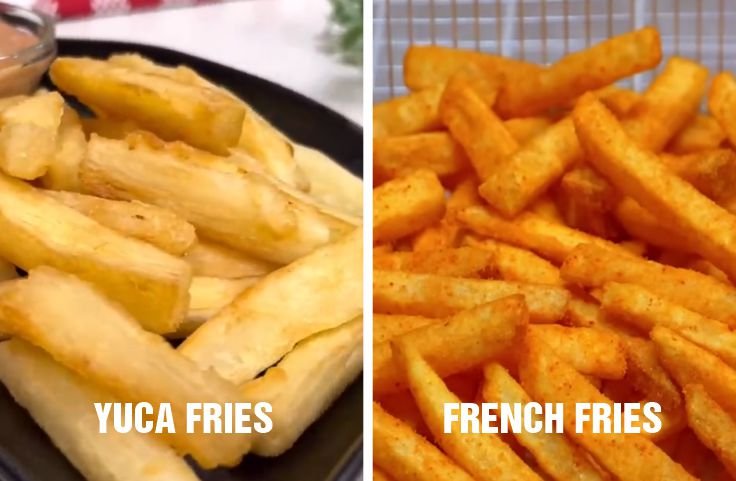Yuca fries vs French fries is more than just a swap of ingredients; it’s a clash of taste, texture, and tradition that might just change the way you see fries.
Yuca fries vs French fries is a debate worth biting into. You’ve probably had your fair share of golden potato fries, but yuca brings something else to the table.
If you’ve ever wondered why these two fries feel so different in your mouth or leave you satisfied in distinct ways, you’re not alone.
Taste, texture, nutrition, and even cultural roots shape how each one shows up on your plate.
This comparison gives you more than surface-level details; it gives you a closer look at what you’re eating and why it matters.
So before you grab your usual side of fries, take a moment to see how yuca stands up to the classic French fry.
The differences may surprise you and even change what you reach for next time. Let’s break it down, flavor, texture, and all.
Recommended: Guide to Cassava Recipes
Table of Contents
- An Overview of Yuca and Potato Fries
- Flavor Comparison: Yuca Fries vs French Fries
- Texture Comparison: Yuca Fries vs French Fries
- Calories: Yuca Fries vs French Fries
- Nutrition: Yuca Fries vs French Fries
- Cultural and Culinary Context
- Cooking Methods Compared: Yuca Fries vs French Fries
- Which One Should You Choose?
- Frequently Asked Questions
- Conclusion
An Overview of Yuca and Potato Fries
What Are Yuca Fries?

Yuca fries are thick-cut snacks made from cassava root, a dense, starchy tuber native to South America.
Popular in Latin America, the Caribbean, and Africa, they’re typically boiled then fried for a crispy shell and fluffy center.
Yuca’s earthy, slightly nutty flavor and gluten-free nature make it a favorite alternative to potato-based fries. Read the full yuca fries guide
What Are French Fries?

French fries are sliced potato strips fried until golden and crispy. Found worldwide, especially in Western fast food and home cooking, they range from thin shoestrings to thick steak fries.
Their mild taste and soft interior make them a flexible side dish. Usually seasoned with salt, French fries are often served with ketchup, mayo, or custom dipping sauces.
Recommended: Baked Yuca Fries Recipe
Flavor Comparison: Yuca Fries vs French Fries
Yuca fries and French fries may look alike, but the flavors they bring are anything but the same.
Each one offers a distinct experience depending on how you cook, season, and enjoy them.
Yuca Fries: Earthy, Rich, and Made for Bold Seasoning
Yuca fries have an earthy, slightly nutty flavor and a dense bite that soaks up oil and seasoning.
They hold onto garlic, paprika, and spicy sauces with ease. If you enjoy bold dips like chimichurri or aioli, yuca gives you a richer, deeper flavor that stands out with every bite.
French Fries: Mild and Crispy with Familiar Comfort
French fries deliver a classic, neutral flavor with a crisp shell and soft interior.
They pair well with salt, ketchup, or cheese sauce, but don’t hold strong flavors as well.
You get that instant, nostalgic comfort, especially when hot and fresh, but they rely more on texture than deep taste.
Flavor Absorption and Aftertaste
Yuca fries trap flavors better, leaving a lingering taste long after the bite. They absorb spices and oils evenly, adding richness.
French fries lose flavor quickly if left out or overcooked.
You’ll notice yuca’s depth right away, while French fries give you fast, fleeting satisfaction with each crispy bite.
| Category | Yuca Fries | French Fries |
|---|---|---|
| Base Flavor | Earthy and slightly nutty with a denser mouthfeel | Mild, neutral flavor with a soft, starchy base |
| Seasoning Compatibility | Pairs well with bold spices like garlic, paprika, and citrus-based flavors | Works best with salt, pepper, or basic condiments like ketchup or vinegar |
| Texture Impact on Taste | Dense texture absorbs seasoning and oil more deeply | Crisp outside with soft interior, flavor depends more on cooking and topping |
| Best Dip Pairings | Aioli, chimichurri, spicy mayo, avocado-based dips | Ketchup, cheese sauce, mayo, malt vinegar |
| Flavor Retention | Holds flavor longer, especially after frying or baking | Tends to lose flavor quickly if overcooked or left to sit |
| Taste Experience | Rich, layered flavor that stands out | Familiar, comforting taste that relies on add-ons |
Related Posts
How to Make Cassava Fries with Air Fryer
Crunchy Fried Cassava Chips and How to Make Them
Dipping Sauce Recipes for Yuca Fries
What is the Nutritional Value of Cassava Fries?
Texture Comparison: Yuca Fries vs French Fries
Texture plays a big role in how you experience fries. Yuca and French fries offer very different bites, from dense and chewy to light and crisp, depending on how they’re prepared.
Yuca Fries: Thick, Crispy, and Chewy All at Once
Yuca fries feel hearty in your mouth. The root’s dense structure creates a crisp shell with a chewy, starchy center.
They’re usually cut thicker, which gives each piece a satisfying contrast between crunch and softness.
Pre-boiling helps keep the inside tender while frying locks in that golden, flavorful outer crust.
French Fries: Soft, Light, and Melt-in-Your-Mouth
French fries are known for their soft, airy bite with just enough crisp around the edges.
When fried right, the outside becomes golden while the inside almost melts in your mouth.
Cut size changes the texture; thin fries are crispier, while thick cuts like steak fries deliver more softness in each bite.
Texture by Cooking Method: Boiled vs Direct Fry
Yuca fries are usually boiled before frying, which helps lock in moisture and softens the core while still delivering that crispy shell.
French fries are often fried directly, giving them a faster crisp but a lighter interior.
Temperature, oil type, and timing all influence how each fry finishes on the plate.
Texture Comparison Table: Yuca Fries vs French Fries
| Aspect | Yuca Fries | French Fries |
|---|---|---|
| Mouthfeel | Thick, hearty, and chewy with a crispy outside | Light, soft interior with a gentle crisp on the outside |
| Cut Style | Typically thick-cut for a firm, bold bite | Varies widely, shoestring, crinkle, or steak cut affects texture |
| Cooking Prep | Usually boiled before frying to soften the core and retain moisture | Commonly fried directly after cutting, leading to fast crisping |
| Texture Layers | Crunchy on the outside, starchy and dense inside | Crisp edges with a fluffy, melt-in-the-mouth interior |
| After-Bite Feel | Leaves a firm, lasting bite you can chew into | Dissolves quickly for a softer, smoother eating experience |
| Impact of Cooking Method | Boiling plus frying gives a structured finish that holds texture well | Frying alone affects crispness depending on oil, heat, and thickness |
Related: 12 Cassava Foods from Latin America
Calories: Yuca Fries vs French Fries
Calorie content plays a big role when choosing between yuca fries and French fries.
Both can be delicious, but the way you prepare them affects how they fit into your daily goals.
French Fries: High Energy with Heavy Oil
A 100-gram serving of regular French fries gives you around 319 calories.
Most of that comes from frying oil and starchy potatoes. If you eat fries often, this can quickly add up.
Traditional French fries are energy-dense, especially when deep-fried.
Portion control and cooking method matter when keeping calories in check.
Yuca Fries: Lower in Calories When Baked
Yuca fries baked in the oven or air fryer can have as few as 120 to 160 calories per 100 grams.
That’s a noticeable drop from their fried version, which jumps to about 365 calories. If you’re watching your intake, baked yuca gives you flavor without the calorie overload.
Cooking Method: The Calorie Game-Changer
How you cook your fries changes everything. Deep-frying adds the most calories, no matter the root.
Baking or air-frying helps cut that number down without sacrificing too much texture.
You can also season with herbs instead of sauces to keep the flavor high and the calorie count low.
| Aspect | Yuca Fries | French Fries |
|---|---|---|
| Calories (Baked/Air-Fried) | Around 120–160 calories per 100 grams when baked or air-fried | Typically not air-fried; baked versions are possible but less common |
| Calories (Deep-Fried) | About 365 calories per 100 grams when deep-fried in oil | Roughly 319 calories per 100 grams when deep-fried |
| Calorie Density | Lower energy density when baked or air-fried | Higher energy density due to oil and starchy potatoes |
| Impact of Cooking Method | Baking or air-frying significantly reduces calories compared to frying | Frying adds substantial calories; portion control is key |
| Best Low-Cal Option | Bake or air-fry with light oil and dry seasoning | Choose oven-baked options and avoid heavy toppings like cheese or mayo |
| Everyday Tip | Great for cutting calories while still enjoying fries | Watch your portions and how they’re cooked to avoid unnecessary calories |
Nutrition: Yuca Fries vs French Fries
If you’re paying attention to nutrition, the difference between yuca fries and French fries goes beyond calories.
Nutrients like fiber, vitamins, and minerals all play a role in how these fries affect your body.
Carbohydrates and Fiber: Who Gives You More?
Yuca fries and French fries are both starchy and high in carbs.
Yuca fries provide about 38 grams per 100 grams, while French fries contain around 35 grams.
Yuca also gives you slightly more fiber, helping digestion and keeping you full longer.
Neither option is low-carb, but yuca wins on fiber content.
Sugar and Gluten Content: What to Watch For
Yuca fries have less natural sugar than French fries, which makes them better for low-sugar diets.
Plus, yuca is naturally gluten-free, great if you’re sensitive or celiac.
French fries may contain hidden gluten from cross-contact or coatings, depending on where and how they’re made. Always check the ingredients list.
Vitamins and Minerals: Which Packs More Benefits?
Yuca delivers more Vitamin C, B6, potassium, and manganese than French fries.
These nutrients support your immune system, energy levels, and nerve function.
French fries contain some potassium but lose nutritional value during frying.
If you want more than just comfort food, yuca gives you better nutrient support in each bite.
| Category | Yuca Fries | French Fries |
|---|---|---|
| Carbohydrates (per 100g) | About 38g of carbs. High in starch and provides long-lasting energy. | Around 35g of carbs. Slightly lower but still starchy and energy-dense. |
| Fiber Content | Slightly higher in fiber, aids digestion and increases satiety. | Lower in fiber, less filling and less digestive support. |
| Sugar Content | Lower in natural sugars, better suited for low-sugar diets. | Contains more natural sugars, especially after frying. |
| Gluten Content | Naturally gluten-free, ideal for gluten-sensitive or celiac diets. | May contain gluten due to cross-contact or coatings. Always check labels. |
| Vitamins & Minerals | Higher in Vitamin C, B6, potassium, and manganese. Supports immunity and energy. | Lower in nutrients, though it provides some potassium. |
| Overall Nutrient Value | More nutrient-dense, especially when baked or lightly fried. | Less nutrient retention, especially after deep-frying. |
Cultural and Culinary Context
Yuca fries, made from cassava root, are a staple in Latin American, African, and some Asian cuisines.
Known for their crispy exterior and soft interior, they’re often served with grilled meats or spicy sauces, especially in places like Brazil.
Their preparation reflects deep cultural traditions tied to local ingredients and cooking methods.
In contrast, French fries, originally from Belgium and France, became globally popular through fast-food chains.
Typically cut from potatoes and deep-fried, they’re now served worldwide alongside burgers, sandwiches, and other quick meals.
While yuca fries are shaped by regional flavors and customs, French fries have adapted to diverse palates with toppings like cheese, herbs, and sauces.
Each fry type carries cultural meaning: Yuca fries highlight traditional home cooking and communal dining, while French fries symbolize convenience and globalization.
Both represent more than just snacks, they reflect how food travels, evolves, and connects across different culinary landscapes and social settings.
Cooking Methods Compared: Yuca Fries vs French Fries
The way you cook yuca fries or French fries changes how they taste, feel, and even how your body handles them.
Each method brings its flavor and nutrition to the plate.
Yuca Fries: Boil First, Then Fry for a Crisp Soft Bite
When making yuca fries, you usually start by boiling the peeled root. This softens the dense texture and helps with digestion.
After boiling, you slice them into fry-sized sticks and fry them until golden.
This two-step method gives you a crisp outside and a soft center. If you want a lighter version, try baking or air-frying with light oil instead of deep-frying. See how to make yuca fries here.
French Fries: Classic Deep Fry or a Healthier Oven Option
French fries are commonly deep-fried, creating that golden crisp people love.
The oil adds flavor through browning, but it also raises fat content.
If you want less oil, baking is your friend. It takes longer but needs just a small drizzle of oil.
Whether you go with thick steak fries or skinny cuts, the method changes how they turn out.
Flavor and Texture Depend on How You Cook
Frying brings out stronger flavors and textures in both yuca and French fries, but it also increases calories.
Boiling softens yuca and lets you control the texture before frying. Baking gives both types of fries a crunch with less fat, but timing and temperature matter.
Choose your method based on how crispy or light you want your fries.
| Aspect | Yuca Fries | French Fries |
|---|---|---|
| Preparation Step | Start by peeling and boiling the yuca to soften it before slicing and frying | Cut raw potatoes directly and fry or bake, no boiling needed |
| Common Method | Boil then fry for a crisp outside and soft center | Deep-frying is the most popular for golden, crispy fries |
| Alternative Method | Bake or air-fry with light oil for a healthier option | Oven-baking with minimal oil gives a crunch with fewer calories |
| Flavor Development | Absorbs seasoning well, especially after boiling and frying | Relies on Maillard reaction during frying for flavor and crispiness |
| Texture Outcome | Dense and fibrous with a contrast of crunchy exterior and fluffy interior | Light and airy inside, crispy outside if cooked correctly |
| Nutritional Consideration | Boiling helps reduce antinutrients and aids digestion before frying | Higher fat content due to deep-frying, but baking can lower the fat load |
| Best For | When you want bold seasoning and a filling bite | When you want quick comfort with familiar taste and texture |
Which One Should You Choose?
Choosing between yuca fries and French fries depends on your taste and dietary needs.
If you want something filling with a chewy texture, yuca fries offer that plus more fiber, vitamin C, and potassium.
They’re naturally gluten-free, which makes them a smart pick if you’re avoiding gluten.
French fries, on the other hand, are light, crispy, and familiar.
They cook faster, pair easily with many meals, and tend to be a crowd-pleaser at gatherings.
Yuca fries shine when you’re after bold flavors and a hearty side dish.
French fries win when you want something quick, classic, and comforting. Think about what you’re craving or who you’re serving.
Whether you go for the earthy richness of yuca or the crisp simplicity of potatoes, both bring something satisfying to the table.
Frequently Asked Questions
Are yuca fries healthier than French fries?
Yuca fries can be healthier if baked or air-fried. They contain more fiber and Vitamin C, but also more carbs. The preparation method makes a big difference.
Do yuca fries taste like French fries?
No, yuca fries have a denser, nuttier flavor and chewy bite. French fries are milder with a crisp outside and soft, starchy center.
Which is lower in calories: yuca fries or French fries?
Baked yuca fries are lower in calories. Deep-fried yuca and French fries have similar calorie counts, but air-frying yuca gives the lowest total.
Are yuca fries gluten-free?
Yes, yuca fries are naturally gluten-free. French fries can be gluten-free too, but cross-contamination or coatings in restaurants may pose a risk.
Conclusion
Yuca fries vs French fries is more than a food choice; it’s about what you want from your meal.
Yuca fries bring a chewy texture, earthy flavor, and more nutrients, especially when baked or air-fried.
They work well with bold dips and seasonings. French fries, on the other hand, give you quick comfort and a familiar crunch.
They’re easier to find, faster to cook, and always a hit with crowds. If you’re watching calories or need gluten-free options, yuca fits the bill.
If you’re after that classic, salty bite, French fries win. Either way, both options satisfy in different ways; it just depends on your mood.
References

Chimeremeze Emeh is a writer and researcher passionate about Africa’s most transformative root crop—cassava. Through his work at cassavavaluechain.com, he explores the entire cassava industry, from cultivation and processing to its diverse applications in food, health, and industrial use.
He also writes for palmoilpalm.com, where he shares his extensive experience and deep-rooted knowledge of palm oil, covering red palm oil, palm kernel oil, and refined products. His work there reflects his lifelong connection to agriculture and his commitment to promoting sustainable value chains in Africa.
Driven by curiosity and purpose, Chimeremeze aims to shed light on how cassava continues to empower communities, strengthen food systems, and link traditional farming wisdom with modern innovation.

